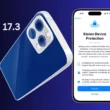Mysk Security Reveals – iPhone Push Notifications Exploited by Malicious Players for Sneaky Data Harvesting!
The security researcher found users privacy concerns in iPhone push notifications, the apps accessing the accelerometer. Discuss what the accelerometer is and how it is used in iPhones.
It also details some privacy concerns regarding app access to this sensor. Some apps have been found to collect accelerometer data even when they don’t need it. This data can be used to infer a user’s location, heart rate, and even breathing rate.
Browsers can also access accelerometer data. iOS 13 introduced a permission dialogue for websites that request accelerometer data. However, Google Chrome on Android shares this data by default.
iPhone Apps and the Accelerometer: A Privacy Deep Dive
In the age of smartphones, our pockets hold not just communication devices, but treasure troves of personal data. Among the sensors silently collecting information in our iPhones is the accelerometer, a motion-detecting marvel that can track our every step, tilt, and even shake. But how do apps access this data, and what privacy concerns does this raise in iPhone push notifications?
Mysk researchers found that iPhone apps send device info and analytics to remote servers via push notifications, even when the app is closed.
The Accelerometer: A Window into Movement
Imagine a tiny, in-built seismometer within your iPhone. That’s the essence of the accelerometer. It measures changes in the phone’s position and acceleration, enabling a range of features we often take for granted. Fitness apps track steps and runs, gaming apps respond to tilts and shakes, and even auto-rotation adjusts to your screen’s orientation.
Apps on the Move: When Convenience Meets Collection
Many apps legitimately require accelerometer access for their core functionalities. Fitness trackers need to count steps, game controllers rely on tilts and swipes, and even augmented reality apps use motion data to overlay virtual objects onto the real world.
However, concerns arise when apps collect accelerometer data beyond their apparent needs. Some fitness apps have been found tracking movements even when not in use, potentially revealing activities like walking the dog or late-night strolls. This data, when combined with other information, can be used to infer a user’s location, routines, and even health metrics like heart rate or breathing patterns.
Privacy in the Balance: Striking a Chord Between Features and Freedom
The potential misuse of accelerometer data raises significant privacy red flags. Imagine targeted ads based on your walking patterns, insurance premiums influenced by your activity levels, or even health conditions diagnosed through phone-based gait analysis. The possibilities, while futuristic, paint a concerning picture of a world where our phones track not just our steps, but our very lives.
Apple, recognizing these concerns, introduced a permission dialogue in iOS 13, requiring users to explicitly grant websites access to accelerometer data. This is a positive step towards user control, but the onus remains on app developers to be transparent about data collection practices and to limit it to what’s necessary for the app’s core functionality.
Beyond iPhones: A Broader Look at Sensor Privacy
The issue of accelerometer privacy extends beyond iPhones. Android devices have similar sensors, and concerns exist about data collection practices across various platforms. Users deserve to be informed and empowered when it comes to their sensor data. Clear app permissions, granular control options, and robust data protection regulations are crucial steps towards a future where convenience and privacy can coexist.
Also Read: How To Block and Prevent Push Notifications Spam?
A Call for Vigilance and Action
The accelerometer, a marvel of engineering, has become a ubiquitous part of our smartphone experience. While it unlocks a world of possibilities, it also raises critical privacy concerns. As users, we must be vigilant about the apps we install and the permissions we grant. We must demand transparency from app developers and hold tech companies accountable for responsible data practices. Only then can we ensure that our iPhones remain not just extensions of ourselves, but also protectors of our privacy.
Remember, knowledge is power. By understanding how our phones collect and use data, we can make informed choices and advocate for a future where technology serves us, without sacrificing our fundamental right to privacy.
Apple Announces Changes to iOS, Safari, and the App Store in the European Union
For Developers have new options for app distribution and payment processing. For Users have new controls, disclosures, and expanded protections to reduce privacy and security risks created by the Digital Markets Act (DMA).
The company changes include more than 600 new APIs, expanded app analytics, functionality for alternative browser engines, and options for processing app payments and distributing iOS apps.
The new options for processing payments and downloading apps on iOS open new avenues for malware, fraud and scams, illicit and harmful content, and other privacy and security threats. That’s why Apple is introducing protections — including Notarization for iOS apps, an authorization for marketplace developers, and disclosures on alternative payments — to reduce risks and deliver the best, most secure experience possible for users in the EU. Even with these safeguards in place, many risks remain.
The changes we’re announcing today comply with the Digital Markets Act’s requirements in the European Union, while helping to protect EU users from the unavoidable increased privacy and security threats this regulation brings. Our priority remains creating the best, most secure possible experience for our users in the EU and around the world
said Phil Schiller, Apple Fellow.











